Applying for a patent
It is not difficult to apply for a patent, but there are a number of things you need to know before you start. On this page you can read all about the patent application procedure and the various costs and steps involved.
What is a patent?
A patent is legal proof of the exclusive rights to an invention. These exclusive rights enable the inventor to take legal action against counterfeiters.
You can obtain a patent on an invention that offers a technical solution to a problem. If you are looking for the definition or meaning of a 'patent' or an 'octrooi', please visit the page ‘The Meaning of patent & octrooi’.

THE DIFFERENCE BETWEEN A PATENT AND AN ‘OCTROOI’
What is the difference between a patent and an octrooi is a question we are frequently asked. In the Netherlands there is no real difference. They are synonyms. Patent is the English word for octrooi. Because patent law differs from country to country, the protection of a patent in other countries is different from that of a patent in the Netherlands. You can read all about this in our blog: The real difference between an 'octrooi' and a patent.
WHY APPLY FOR A PATENT?
There are many advantages to applying for a patent.
- A patent offers the exclusive right to use a product or process commercially for a period of up to twenty years. It creates a temporary monopoly.
- A patent increases the value of your business. This can be attractive in the event of a takeover or in the search for an investor, for instance.
- A patent is a commodity.
You can sell your intellectual property rights to another party, or issue licences on your patent. If you do so, you give that party permission to use your invention commercially in return for payment. - A patent can be used as a marketing tool.
By mentioning a patent in a marketing campaign, you show that the product is innovative. As a result, consumers are more inclined to pay a higher price for it. - A patent makes it possible for you to use the Innovation Box, a government tax incentive, and thus save on taxes.
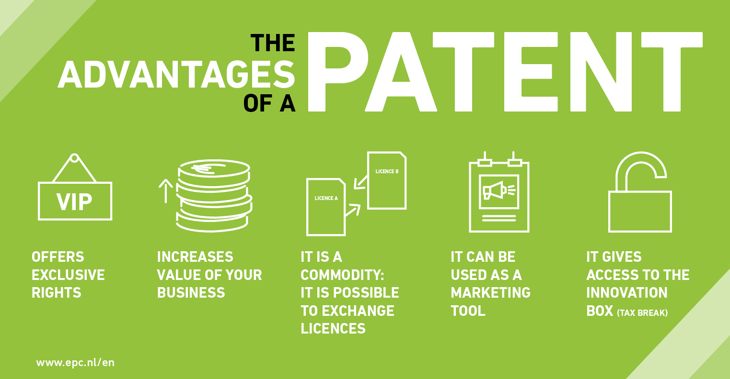
WHAT KIND OF THINGS CAN BE PATENTED?
You can apply for a patent on an invention that provides a technical solution to a problem. This means that lots of products are patentable. Everyone uses patented products on a daily basis, such as mobile phones, electric toothbrushes or the technology in their cars. However patents are not just limited to products as a process or an active ingredient can also solve a technical problem and is therefore patentable.
So, what kind of things can be patented?
- Products - such as a bicycle saddle.
- Processes - for example the way in which signals are transmitted in mobile phones.
- Substances - such as a drug.
- Uses - for example, if substance X is used as a stain remover, but also proves effective in exterminating oak processionary caterpillars, then you can patent this 'use'.
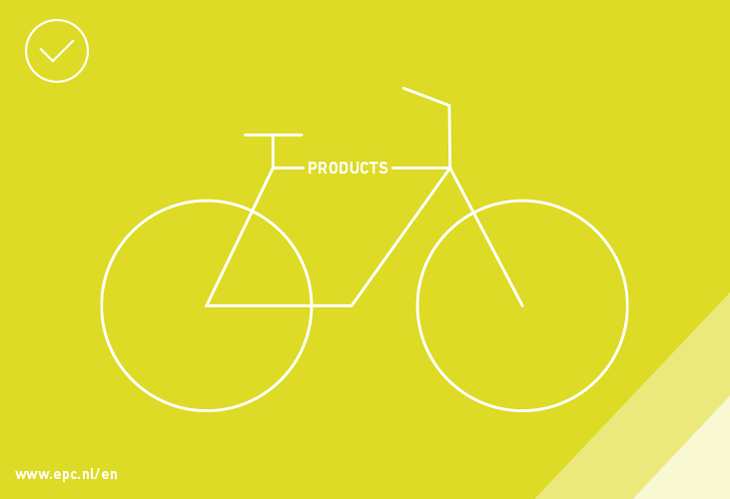
But not everything is patentable. If you want to apply for a patent on an idea, your idea will have to meet a number of conditions. These conditions can be found here.
Secrecy
It is important to keep your invention secret at all times, at least until the patent application has been filed. If the invention has not been kept secret, it is no longer novel. After all, everything that is in the public domain at the time when the patent application is filed is prior art. Even after filing, it is sometimes advisable to keep the invention secret. You should always consult a patent attorney before bringing the invention into the public domain.
PROTECTING SOFTWARE
It is often not clear whether or not software is patentable. If the software provides a technical solution to a technical problem, it is but it is not always clear when and if this is the case. Our software expert Holger Seitz can advise you as to whether or not your specific invention in this field is patentable.
WHAT KIND OF THINGS CANNOT BE PATENTED?
PATENT ON A NAME
You cannot apply for a patent on simply everything. It is not possible to apply for a patent on a name, for instance. There are other forms of protection for this, such as trademarks or trade names.
PATENT ON AN APP
We are also often asked whether it is possible to apply for a patent on an app. This is only possible if the app provides a technical solution to a problem. For example, if the app can be used to operate the solar panels on your roof.
Furthermore, you cannot apply for a patent on:
- A logo
- A spelling
- A colour combination
- A software programming code
- The appearance of a newly designed item
- A company name
- Works of art
- Books or publications
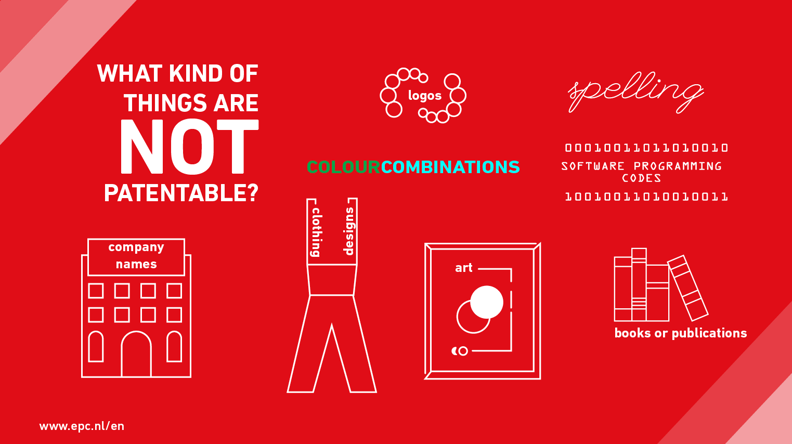
There are other ways in which the above can be protected. These are described in the brochure entitled 'Forms of protection for innovations'. For instance, if you would like to protect the appearance or the design of a newly designed item you could apply for a Design Right.
COSTS OF APPLYING FOR A DUTCH PATENT
Applying for a patent is an investment that only start to pay off at some point in the future. By making clever use of the various procedures (e.g. the PCT route) you can spread the costs over a longer period of time. However, there are a number of costs that cannot be avoided.
The costs of applying for a Dutch patent are made up of the following components:
| Costs of applying for a Dutch patent | ||
|---|---|---|
| Conducting a search | € 1,500 |
|
| Costs of engaging a patent attorney | € 6,500 to € 8,500 |
|
| Filing fees | € 750 or € 1,500 |
|
| Advice novelty report | €1,000 to €1,500 | |
| Renewal fees for the first 5 years |
€ 140 |
|
The exact costs of applying for a patent depend on a number of factors, such as:
- The purpose of the patent
- The complexity of the innovation; an innovation in Life Sciences or Chemistry is often more complex than an innovation in the field of Mechanical Engineering.
- The number of variants in which your invention can occur
After a free initial consultation, we will be happy to give you an estimate of the costs involved for your specific situation. In this article you can find out more about the various components that make up the costs of applying for a patent.
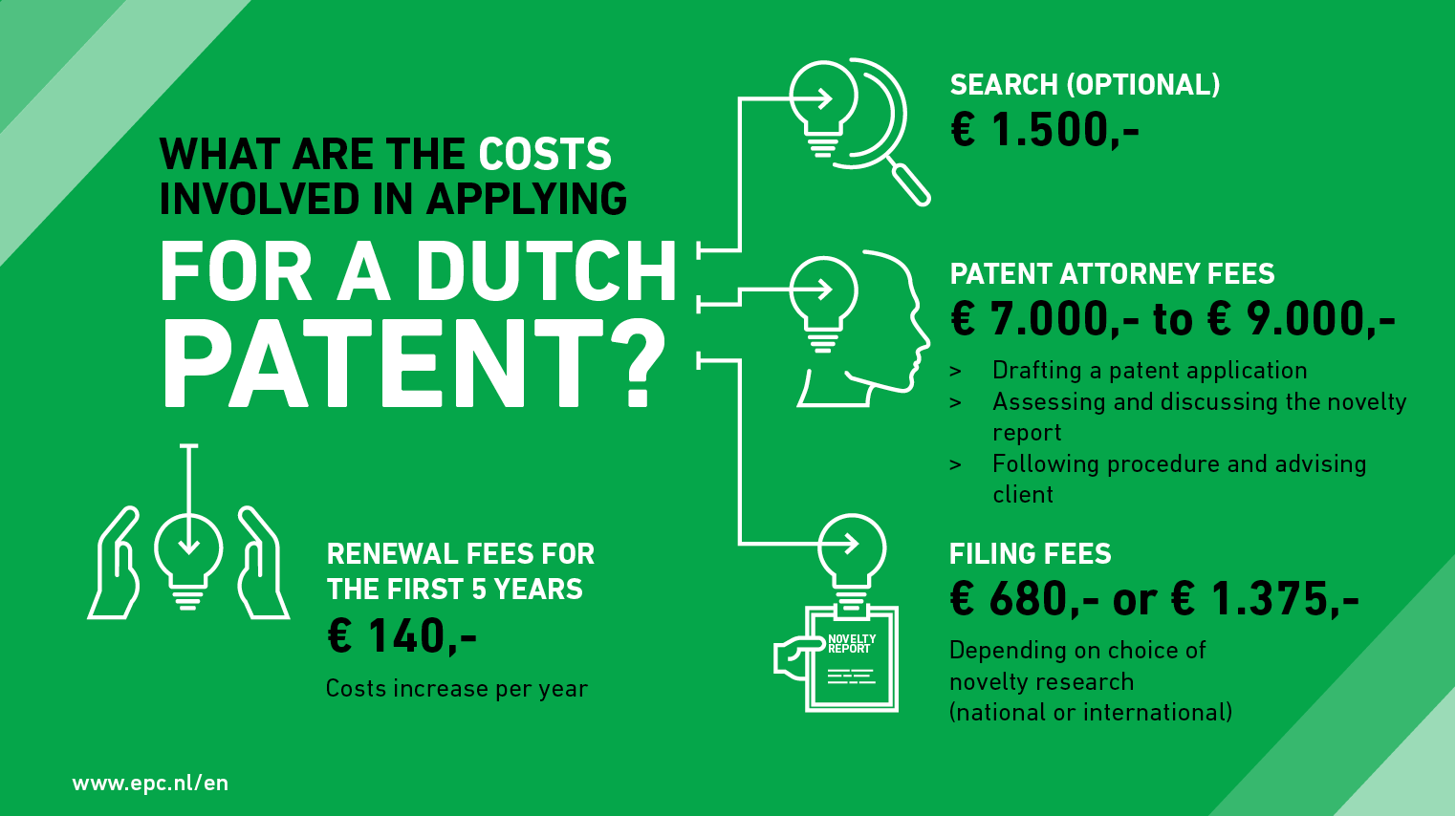
RENEWAL FEES FOR THE NETHERLANDS
Once your patent has been granted, you can start reaping the benefits. In order to continue to do this for the full twenty years, you will have to pay a renewal fee. This is an annual fee which goes up over the course of the term. If you fail to pay it, your patent will expire and everyone will be free to copy your invention.
| Year | Fee (euro) |
|---|---|
|
1 t/m 3 |
0 |
|
4th year |
40 |
|
5th year |
100 |
|
6th year |
160 |
|
7th year |
220 |
|
8th year |
280 |
|
9th year |
340 |
|
10th year |
400 |
|
11th year |
500 |
|
12th year |
600 |
|
13th year |
700 |
|
14th year |
800 |
|
15th year |
900 |
|
16th year |
1,000 |
|
17th year |
1,100 |
|
18th year |
1,200 |
|
19th year |
1,300 |
|
20th year |
1,400 |
|
21th year* |
1,600 |
|
22th year |
1,800 |
|
23th year |
2,000 |
|
24th year |
2,200 |
|
25th year |
2,400 |
|
26th year |
1,300 |
*In principle, a patent is granted for a maximum period of 20 years. However, there are exceptions to this rule.
COSTS OF APPLYING FOR A EUROPEAN PATENT
The costs of applying for a European patent are made up of the following components:
| Costs of applying for a European patent | ||
|---|---|---|
|
Conducting a search |
€ 1,500 |
|
|
Costs of engaging a patent attorney |
€ 6,500 to € 8,500 |
|
|
Filing costs European patent |
€ 5,305 |
Including novelty report* |
|
Costs of renewing |
€ 1,000 to € 2,000 per country |
|
|
Renewal fees |
Once the patent has been granted you will need to pay renewal fees per country. |
|
*If you apply for a European patent on the basis of a Dutch patent, the costs of the novelty report will not apply.
COSTS OF A PCT APPLICATION
The PCT route makes it possible to obtain international protection for your invention. The costs of a PCT application are as follows:
| Costs PCT-application | ||
|---|---|---|
|
Costs of engaging a patent attorney |
€ 6,500 - € 8,500 |
|
|
PCT filing fees |
€ 4,500 |
|
In practice, we often start with a Dutch patent in order to subsequently file a PCT application. There are several advantages to this. Your patent attorney will be happy to explain this to you.
WHEN SHOULD YOU OPT FOR A DUTCH PATENT?
- If you quickly want to have a patent.
A Dutch patent application can be completed within a period of 18 months. This gives you a priority date which you can use to protect your innovation outside the Netherlands. A Dutch Patent is an excellent steppingstone to obtaining international protection for your invention, for example via the PCT route. - If you want to have a novelty report carried out at a relatively low cost.
This report provides you with information on the strength of the patent. - Als u gebruik wilt maken van de Innovatiebox.
There are many more advantages to a Dutch patent. You can read all about them in this blog.
WHEN SHOULD YOU OPT FOR A EUROPEAN PATENT?
- When you are very clear about where your markets lie within Europe.
You can read all about how to apply for a European patent here.
WHEN SHOULD YOU OPT FOR A PCT APPLICATION?
- If you need time to explore the market and identify commercial opportunities.
- If you want to put off the (major) costs of IP protection to a later date.
- If you need time to look for investors.
You can read more about this in the blog 'Advantages of the Dutch PCT route'.
SAVE COSTS BY INVESTING IN A SOLID FOUNDATION
At EP&C we advise against economising on the writing of a patent application. By focusing on the foundations, your patent application will be solid and the granting procedure will run more smoothly. As a result, the final costs will be lower.
You will be able to reap the benefits of this investment in the future. After all, a patent has to last 20 years. This means it has to be closely in line with your objectives and your business strategy and has to be flexible enough to enable you to respond to future developments.
You can find more information on the types of things you can save on in this blog.
CONDITIONS FOR APPLYING FOR A PATENT
First of all, there are three conditions an invention has to meet in order to be patentable:
- Novelty
- Inventive step
- Industrial applicability
NOVELTY
An invention has to be novel. This means that it must not have been brought into the public domain anywhere in the world until the filing date of your patent application. This novelty requirement is strict and is very far-reaching, although there are a few exceptions. Your patent attorney will be happy to provide you with more information on this.
INVENTIVE STEP
One of the other requirements for a patent is that the invention must be inventive. This means that the invention is not obvious to a non-creative insider in the technology in question. In practice, we see that techies often take this requirement too literally. What may be 'obvious' to them, may well be inventive to the average person skilled in the art.
INDUSTRIAL APPLICABILITY
You can apply for a patent on a technical solution to a problem. The invention must be industrially applicable in order to qualify for a patent.

A PATENT APPLICATION
A patent application is a document with a fixed layout.
- A description of the nearest prior art.
- The presentation of your invention.
- A presentation of the invention in the form of figures.
- The conclusion: a point-by-point description of the invention.
A patent application is a text that has to comply with statutory rules. As a result it is not an easy text to read. This article explains how best to read a patent text.
EXAMPLE OF A PATENT APPLICATION
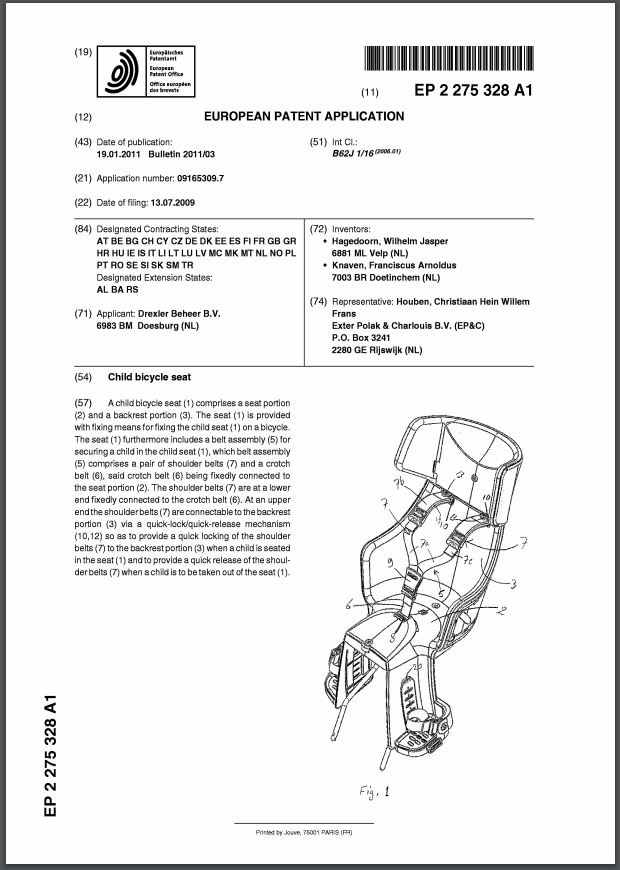 Take a look at this example of a patent in Espacenet.
Take a look at this example of a patent in Espacenet.
What is a patent?
A patent is an agreement with society to stimulate innovation. Inventors are given the exclusive right to market their invention as a reward for their innovation for a maximum period of twenty years. In return, they must bring their innovation into the public domain, so that the knowledge is available to everyone.
HOW DO YOU APPLY FOR A PATENT?
The procedure for applying for a patent is made up of seven steps:
- Assessment of the feasibility and return on investment
- Drafting of the patent application
- Filing of the patent application
- Receipt of patent search: novelty report
- Checking the patent: Go or no go
- Granting and publication of the patent
- Renewal of the patent
1. ASSESSMENT OF FEASIBILITY AND ROI
The first step towards applying for a patent for your invention is to give the matter some serious thought once more. That is because applying for a patent takes a lot of time, energy and money. Do you have any idea of the return on investment (ROI)? In other words: what is the relationship between the returns and the investment?
And is applying for a patent the best choice? In short: think carefully before you decide to opt for a patent. Sometimes there are smarter ways to protect your innovation.
2. DRAFTING THE PATENT APPLICATION
It is important to draw up the patent application in accordance with the set rules. A patent application must meet the requirements of:
- Clarity
- Replicability
CLARITY
One important criterion for a good patent application is clarity. The application must describe exactly what is being protected. Vague terms such as 'the product consists almost 100% of material x' will not stand up in the unlikely event of a lawsuit. The other party will make 100% mincemeat of this.
REPLICABILITY
Another requirement for a good patent, which is at least as important is replicability. This means that the invention must be described in such a way that a person skilled in the art can reproduce the invention.
Drawn up by a professional
The art of a good patent application is to disclose enough information to meet the replicability requirement but at the same time not give away all the details. In this way you will not be making competitors unnecessarily wiser.
3. FILING THE PATENT APPLICATION
Once the patent application has been drawn up, it is filed with the patent granting authority in the Netherlands, the Netherlands Patent Office (OCNL).
FILING
The patent attorney will take care of the actual filing. A filing fee is payable for this. At the same time, an application for a novelty search is filed. This can be either a national or an international search. The OCNL carries out the national search, while the European Patent Office (EPO) carries out the international search. In essence, the searches are the same, although the EPO search is more expensive. However, the EPO search provides more insight into the strength of your patent application. If you want to apply for a patent outside the Netherlands at some point in the future, an international search is usually a better choice.
ASSESSMENT
Once your patent application has been filed, the OCNL will assess it on the basis of the procedural rules. After approximately two months, the party who filed it will be told if any procedural defects have been found. If your application has been filed by a reputable patent office, procedural defects are rarely found.
4. RECEIPT OF PATENT SEARCH NOVELTY REPORT
You will receive the novelty report from the OCNL or EPO approximately nine months after filing your patent application. This report describes how the examiner assesses your chances of obtaining a patent based on written research. The main focus of this study lies in the novelty, inventive step and industrial applicability of your invention. Our brochure entitled 'Reading guide for your novelty report' will help you understand this document.
Incidentally, a negative assessment does not by definition have to be a problem. The patent attorney will often have chosen to draw up the claims in very general terms in order to obtain the broadest possible protection. The patent application can still be adjusted at this stage. Any claims that are not novel or inventive can still be changed.
5. CHECKING THE PATENT: GO OR NO GO
This is an important moment in the patent application procedure. Based on your novelty report, you and your patent attorney assess the chances of obtaining a valuable patent. Together you decide what the next step is going to be. There are three options:
a. PROCEED WITH THE PATENT APPLICATION
The novelty report did not provide any information on the basis of which the patent application needs to be changed. You do not need to take any steps; the granting procedure will continue and your patent will be granted soon after.
b. CHANGE THE PATENT APPLICATION
The novelty report is not all positive, but with a number of changes to the text you can overcome these objections.
You can change the claims of the patent application. However, you should bear in mind that in some cases these changes will affect the date of your application. Because close to a year will have passed by now, the prior art may have changed in the meantime. Your patent attorney can explain the ins and outs to you.
c. WITHDRAW THE PATENT APPLICATION
Finally, it is possible to withdraw the patent application at this stage. It is possible, for example, if the novelty report shows that the patent application has no chance of success or that the desired protection cannot be obtained after all. It may then be wise to withdraw the application. As a result, the patent application will not be made public and you will not make your competitors unnecessarily wiser.
6. GRANTING AND PUBLICATION OF THE PATENT
Approximately eighteen months after your application was filed, your patent will be published and entered in the Dutch Patent Register. From that moment on, you will have a registered patent and your patent will be in the public domain. Two months later you will receive your patent certificate, i.e. the actual paper certificate.
INFRINGEMENTS
From the moment the patent is granted, you can take steps against parties who infringe it. If another party is infringing while the granting procedure is still ongoing, you can tell them that you have filed a patent application (patent pending) and that you will take steps as soon as the patent has been granted. In both cases, it is advisable to discuss the matter with your patent attorney so that you can deal with infringers in the appropriate manner.
NO PATENT POLICE
There is no such thing as patent police. In other words, there are no bodies that check whether someone is infringing your patent. So it is up to you to keep an eye on this and to actively use your patent. For tips, read the blog entitled 'The patent police are my best friend, right?'.
TIP: use everyone’s ears and eyes in your organisation to detect possible infringements!
7. RENEWAL OF THE PATENT
Once your patent has been granted, you can start reaping the benefits. In order to continue to do this for the full twenty years, you will have to pay a renewal fee. This is an annual fee which goes up over the course of the term. If you fail to pay it, your patent will expire and anyone is free to copy your invention.
Why do the renewal fees keep increasing?
The renewal fee goes up each year as an incentive to let unused patents expire. A patent confers a monopoly, whereas our economy is based on free market forces. In essence, monopolies are therefore undesirable. By asking for ever higher fees, the government ensures that applicants only maintain their monopoly if it is profitable for the patent holder.
TIP: evaluate with your IP team each year whether maintaining your patent still contributes to your business plan.